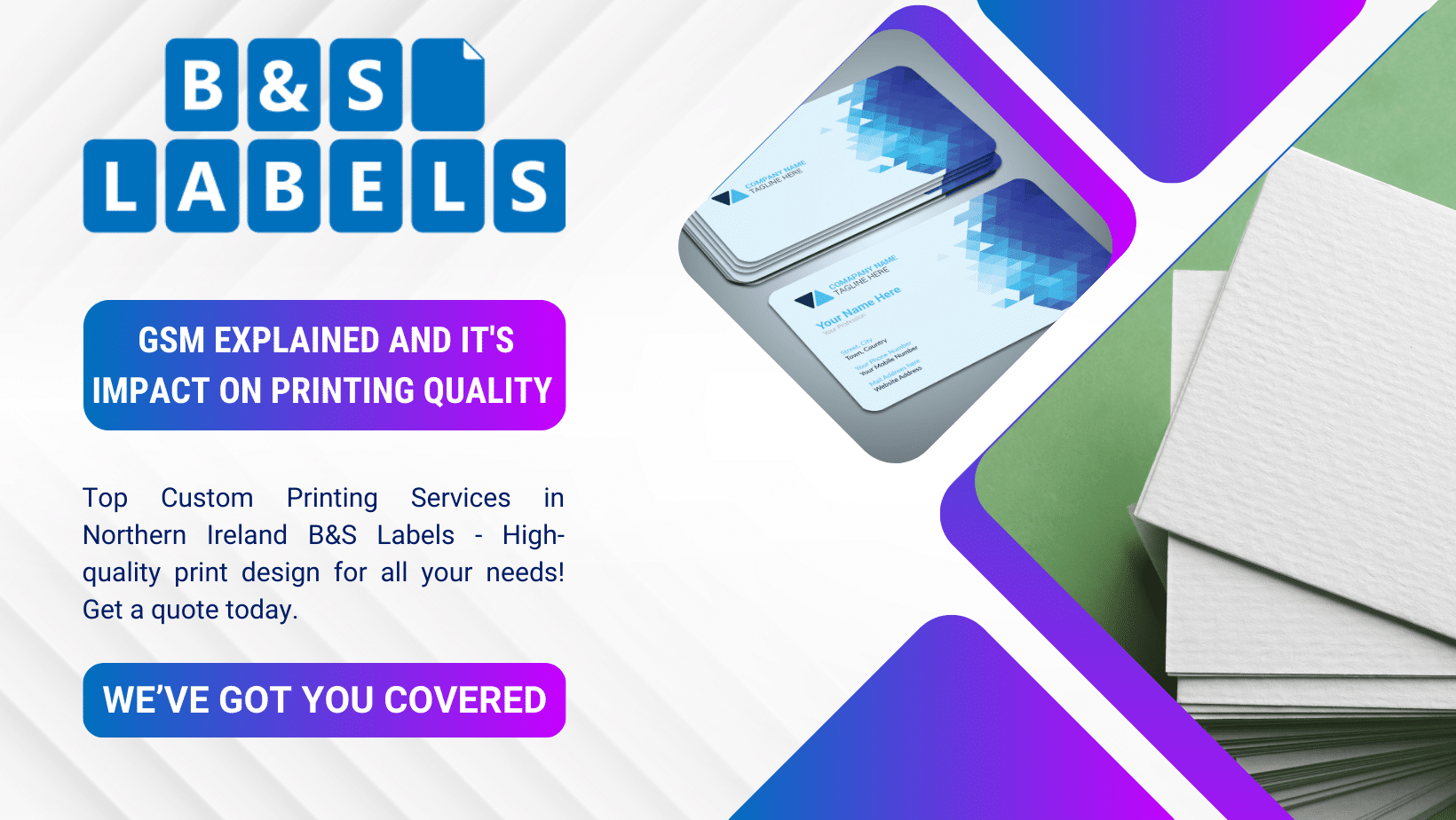How Paper GSM Explained Impacts Printing Quality
What is The Best GSM Paper for Business Cards, Flyers, and Brochures
The Best GSM Paper for Business Cards
When it comes to creating high-Printing Quality, choosing the right GSM (grams per square meter) is essential. For business cards, opt for 300-400 GSM paper. This thickness offers a sturdy and professional feel, perfect for leaving a lasting impression.
The Best GSM Paper for Flyers
For flyers, 130-170 GSM is ideal. It strikes the right balance between being lightweight for distribution and durable enough to maintain quality.
The Best GSM Paper for Brochures
For brochures, 170-250 GSM works best. It provides a premium look while allowing easy folding for bi-fold or tri-fold designs.
The right GSM ensures your printed materials stand out with the perfect balance of durability and elegance.
Did you know that the grammage of paper, often referred to as GSM, can significantly influence your printing quality? Understanding paper GSM is vital for achieving the desired results, especially when using coated paper or silk finishes. In this post, we will delve into how paper size and GSM affect printing techniques and quality, along with best practices for selecting the right paper for your needs. By addressing common challenges related to paper selection, you’ll gain insights that will enhance your print projects while considering sustainability.
Understand the Concept of Paper GSM and Its Significance
GSM, or grams per square meter, represents a key measurement that defines the weight and thickness of paper, thereby influencing its characteristics, including durability and print quality. The history of paper GSM measurements dates back to the need for standardized paper grades, and several factors impact these measurements, such as fibre type and manufacturing processes. Different types of paper, categorized by GSM, serve varied purposes, from stationery to offset printing and banners. Selecting the appropriate GSM is crucial for achieving optimal results while considering environmental implications, ensuring that both quality and sustainability are addressed.
Define GSM and Its Role in Paper Characteristics
The GSM measurement, or grams per square meter, fundamentally affects the paper characteristics that determine printing quality. Papers with a higher GSM typically exhibit increased thickness and durability, translating to better handling and longevity. For instance, a poster printed on a sturdy, high-GSM stock will maintain its integrity and vibrancy over time, benefiting from a smooth surface conducive to higher dots per inch (DPI) output during printing.
Understanding paperweight in terms of GSM can help users select the appropriate type for their projects. For example, lightweight papers may be ideal for everyday printing but may lack the quality needed for professional prints or marketing materials. By considering the GSM and the micrometre measurement of the paper‘s thickness, individuals can optimize their printing efforts, ensuring that their materials not only look professional but also stand up well to handling, which is particularly important in the competitive online marketplace.
Explore the History of Paper GSM Measurements
The concept of GSM (grams per square meter) has its roots in the early manufacturing processes of paper, particularly in the United States, where standardization became essential. Before GSM was adopted, different regions used various methods to gauge paper weight, leading to confusion in quality and usage. The establishment of GSM as a unit of measurement not only provided clarity for consumers but also ensured consistent quality across various types of paper, including notebook sheets and satin finishes, which require specific weights for optimal performance.
Identify Key Factors That Influence Paper GSM
Several key factors influence paper GSM, significantly affecting printing quality. The type of raw materials used plays a critical role; for instance, high-quality fibre can enhance the strength and texture of the paper. When producing art prints, selecting a GSM that can best hold ink without bleeding ensures that vibrant colours remain sharp and well-defined, appealing directly to the target audience looking for superior visual presentation.
Another important element is the manufacturing process, particularly for specialized papers such as tissue paper or thicker card stock. The machinery, pressure applied during production, and moisture content all contribute to the final GSM. Printers utilizing laser technology often prefer specific weights to achieve optimal results, as lightweight sheets may not withstand the heat and pressure during printing. Understanding these factors empowers creators to choose the right paper for their projects, enhancing overall print quality and durability.
Discuss Different Types of Paper Based on GSM
Different types of paper are categorized based on their GSM, which affects their suitability for various printing applications. For instance, lightweight paper stocks ranging from 60 to 90 GSM are ideal for everyday documents such as reports or flyers, while heavier stocks, around 200 to 300 GSM, are preferred for items requiring more durability, such as business cards or thick brochures. In creative software like Adobe InDesign, selecting the appropriate GSM ensures that printed materials deliver clear, professional results that stand up to handling and enhance the overall presentation.
Lamination can also influence the choice of paper GSM. For example, when creating high-quality products like menus or catalogues, choosing a stock with a higher GSM provides a sturdy foundation that, when laminated, retains its appeal and durability over time. Accurate GSM selection makes a tangible difference in print quality, helping designers achieve the intended visual impact while addressing their client’s needs for longevity and professionalism in their printed materials.
Highlight the Importance of Selecting the Right GSM
Selecting the appropriate GSM is essential for achieving the desired graphics and aesthetics in printed materials. For instance, a postcard printed on a heavier GSM stock will deliver a more durable and professional appearance, allowing it to withstand wear during mailing and handling. This quality not only enhances visual appeal but also increases the likelihood of engaging recipients, addressing the needs of businesses looking to make a lasting impression through their marketing efforts.
The choice of GSM also plays a critical role when using adhesive applications in graphics. A lightweight stock might buckle or warp under such conditions, compromising the integrity of the design. By opting for the right GSM, individuals and businesses can ensure their printed products, such as promotional flyers or postcards, maintain their shape and visual integrity, ultimately fostering trust and professionalism in communications, whether in print or as a supplement to digital channels like email.
Explain How GSM Affects Environmental Considerations
The GSM of paper plays a significant role in environmental considerations connected to printing practices. For brands producing newspapers and magazines, choosing the right GSM not only affects the printing quality but also determines the sustainability of the product. Opting for papers with a lower GSM can lead to less raw material usage while still delivering adequate durability for everyday publications, which aligns with eco-friendly printing initiatives and reduces waste during production.
In the case of books, the GSM selection impacts their environmental footprint over the entire lifecycle. Heavier GSM papers may offer enhanced durability for long-term use, but they often require more resources to produce. Brands committed to sustainability can find a balance by selecting GSM that provides a good compromise between quality and ecological impact, ensuring their printed products remain appealing yet responsible in a market increasingly focused on environmental stewardship.
Analyze How GSM Affects Printing Techniques and Quality
Understanding the relationship between GSM and print quality is crucial in graphic design. This section examines how GSM influences print clarity, explores GSM requirements for various printing methods, and investigates ink absorption rates for different paper stock and paperboard. It also considers print durability and discusses common printing issues that arise from improper GSM selection, providing practical insights for achieving optimal results.
Examine the Relationship Between GSM and Print Clarity
Understanding the correlation between GSM and print clarity is essential for achieving high-quality images in various printing applications. Higher GSM papers, such as those made from cotton or silk fibres, tend to provide better ink absorption which is critical for vibrant colours and crisp details. For instance, using heavier bond paper ensures that advertising materials maintain sharpness during print, resulting in visually compelling products that stand out in a web browser or physical display.
Print clarity is also influenced by the choice of GSM when it comes to specific printing techniques. Lightweight stock may not hold ink effectively, leading to smudging or fading. In contrast, heavier paper stock allows for sharper images and more defined graphics, which is especially important for promotional materials within the advertising field. Selecting the appropriate GSM fosters a clean and professional appearance enhancing both the visual aesthetics and overall impact of printed pieces.
Assess GSM Requirements for Different Printing Methods
Choosing the right GSM according to the specific printing method is crucial for achieving high-quality results. For digital printing, lighter weights typically ranging from 90 to 120 GSM are suitable, allowing for efficient ink absorption and optimal clarity. Users on a budget can benefit from these lighter options, ensuring that the color definition and overall sharpness remain intact while controlling costs without compromising presentation standards.
Offset printing, on the other hand, often requires heavier paper with GSM ranging from 150 to 300 to withstand the additional printing pressures involved. This weight ensures that color saturation is enhanced, maintaining vibrancy across larger prints where length and detail are essential. When users select the appropriate GSM for their printing method, they not only boost visual quality but also ensure that their printed materials stand the test of handling, ultimately achieving their intended impact efficiently.
Investigate How GSM Influences Ink Absorption Rates
The GSM, or grams per square metre, of paper, directly influences how well it absorbs ink, which is crucial for printing quality. Papers with a higher weight typically have a denser pulp, allowing for improved ink retention. This results in vibrant prints that maintain colour integrity and sharpness, especially when precision is vital, such as in marketing materials and professional photographs.
Consider the Impact of GSM on Print Durability
The weight of paper, measured in grams, significantly influences the durability of printed materials. For example, a paperback book printed on high-GSM paper will withstand handling better than one produced on lighter stock. This durability becomes essential for products like wine labels and envelopes, where they are subjected to varying conditions and interactions that could compromise print quality over time.
When considering how GSM affects durability, it is crucial to match the paper weight with its end-use scenario. A printer that utilizes heavier paper for promotional materials, such as brochures, ensures that these items remain intact and visually appealing through distribution and display. Therefore, selecting the right GSM not only enhances the longevity of printed products but also maintains their overall presentation, delivering value to users who require reliability in their printing endeavours.
Discuss Common Printing Issues Related to Improper GSM
Choosing the wrong GSM for specific projects can lead to several common printing issues. For instance, a flyer printed on lightweight paper may not stand up to regular handling, risking creasing or tearing, which diminishes its effectiveness. Similarly, using high GSM for a letterhead can cause printer jams or ink smudging, resulting in a less professional appearance.
Another problem arises when glossy finishes are applied to papers with insufficient weight; the ink may not adhere properly, resulting in blurriness or fading. A hardcover book produced on the wrong stock can also suffer from durability issues, impacting its longevity and overall aesthetic appeal. Addressing these concerns through careful GSM selection can significantly improve the final output and ensure the printed materials meet quality expectations.
Discover the Relationship Between GSM and Paper Finishing
The relationship between GSM and paper finishing is crucial for achieving high-quality printed products in marketing, particularly for items like menus and large format displays. Various finishing techniques can be influenced by the GSM, affecting coating processes and texture, while also enhancing visual appeal. Understanding how different GSM options contribute to specialized finishing is essential for optimizing the final dimensions of printed materials.
Identify Finishing Techniques Affected by GSM
The GSM of paper significantly influences various finishing techniques, impacting the overall quality of printed products. For example, heavier GSM stock is often more compatible with foiling and embossing processes, producing clearer and more defined results. This is essential for items like business cards or luxury packaging, where visual impact is crucial for brand perception and customer engagement.
Furthermore, lighter GSM papers require different treatment methods for effective finishing. When applying coatings or laminations, a lightweight stock may not hold up as well, possibly leading to issues like bubbling or uneven coverage. Understanding the interplay between GSM and finishing techniques helps designers and printers select the right materials to enhance the aesthetics and functionality of their printed projects, ensuring they meet quality expectations.
Analyze the Effects of GSM on Coating Processes
The GSM of paper plays a vital role in coating processes, directly influencing the adhesion and effectiveness of applied finishes. Heavier GSM papers often provide a more robust surface that enhances the ability of coatings, such as gloss or matte finishes, to adhere properly. For instance, when applying UV coatings to heavier stock, the result typically delivers a smoother, more uniform appearance, elevating the visual quality of the final product.
Lighter GSM papers can present challenges during coating applications due to their thinner structure, which may not support certain finishes as effectively. This can lead to issues like bubbling or uneven coverage, compromising the intended visual impact. Understanding the relationship between GSM and coating processes enables designers to select the right paper for their projects, ensuring both aesthetic appeal and durability in printed materials.
Evaluate How Different GSM Options Impact Texture
The texture of paper is significantly influenced by its GSM. Higher GSM stocks typically feature a more robust surface, enhancing the tactile experience. For example, cardstock used for greeting cards has a smoother, more substantial feel, contributing to a sense of quality and professionalism that can positively impact consumer perception.
Explore the Role of GSM in Enhancing Visual Appeal
The GSM of paper plays a significant role in determining the visual appeal of printed materials, influencing both aesthetics and functionality. Higher GSM papers typically possess a more substantial texture and finish, which enhances the overall quality of print outputs, making colours more vibrant and details clearer. For example, a business card printed on a heavier stock not only looks more professional but also provides a tactile experience that leaves a lasting impression on recipients.
Discuss the Importance of GSM in Specialized Finishing
Selecting the correct GSM is essential in specialized finishing, as it directly affects the effectiveness of various techniques, such as embossing and foiling. For instance, heavier GSM papers tend to provide a more stable surface, which improves the outcome of embossed designs and ensures that foils adhere properly. This attention to detail not only enhances the aesthetic appeal but also reinforces the quality perception of the printed materials
Moreover, lightweight stocks may struggle during specialized finishing processes, leading to issues such as bubbling or uneven coverage. This can undermine the intended impact of high-end designs, particularly in marketing materials where visual presentation is critical. Understanding the importance of GSM in these processes empowers designers to choose suitable materials, ensuring their projects meet both aesthetic standards and functional requirements.
Investigate the Impact of GSM on Cost and Budgeting
Choosing the right GSM significantly influences overall printing expenses. This section compares the cost differences between various GSM options, analyzing budgeting for high versus low GSM papers. It also discusses potential savings achievable through optimal GSM selection and evaluates the cost-effectiveness of different weights. Understanding these factors provides practical insights that enhance financial decision-making for printing projects.
Calculate How GSM Affects Overall Printing Expenses
Understanding how GSM, or grams per square meter, affects overall printing expenses is vital for budget-conscious businesses. Higher GSM papers typically cost more due to their density and quality, which can lead to improved durability and aesthetics. For example, a marketing firm choosing between lightweight 90 GSM for everyday flyers and thicker 300 GSM for high-end brochures must weigh the initial cost against the potential impact on brand perception and customer engagement.
Firms can optimize their budgets by selecting the appropriate GSM for specific applications. Lightweight options may reduce printing costs on routine documents, while investing in heavier stocks for promotional materials could yield greater returns due to enhanced visual appeal and longevity. This strategic GSM selection not only helps control expenses but also ensures that printed materials effectively communicate the desired message to the target audience.
Compare Cost Differences Between GSM Varietie
The cost differences between various GSM paper types can significantly impact budgeting for printing projects. High GSM options, which often deliver superior durability and print quality, generally come at a premium price. For instance, selecting heavyweight paper for marketing brochures might lead to higher initial expenditures, but the investment can enhance overall brand perception and customer engagement, ultimately justifying the expense.
On the other hand, lower GSM papers are more budget-friendly and can be ideal for routine printing tasks. Choosing these lighter stocks for everyday documents can effectively reduce overall printing costs without sacrificing basic functionality. However, businesses must weigh these savings against the potential drawbacks, such as diminished visual appeal and durability for high-impact materials, ensuring that their choice aligns with their specific printing needs and marketing goals.
Analyze Budgeting for High vs. Low GSM Papers
Budgeting for high versus low GSM papers involves carefully considering how each option aligns with specific project goals. High GSM papers generally carry a higher cost due to their enhanced durability and quality. For instance, while a marketing firm may choose lightweight 90 GSM paper for everyday flyers, investing in 300 GSM for premium brochures can yield greater returns through improved brand perception and customer engagement, ultimately enhancing the overall printing quality.
Furthermore, businesses must assess the longevity and visual appeal associated with each GSM type when planning budgets. While lighter papers may be cost-effective for routine documents, opting for heavier stocks for high-impact materials mitigates the risk of issues such as creasing or tearing, which can occur with lower GSM. This strategic approach ensures that while initial expenses might increase with high GSM options, the return on investment in terms of quality and effectiveness justifies the cost, promoting successful communication and marketing initiatives.
Discuss Potential Savings With Optimal GSM Selection
Optimal selection of paper GSM can lead to significant cost savings for businesses, ensuring that printing projects remain budget-friendly while maintaining quality. For instance, a company that chooses a lightweight paper for basic documents can effectively lower printing costs without sacrificing functionality. By strategically selecting GSM based on the project’s requirements, organizations can balance quality and expenses, enhancing their overall profitability in printing operations.
Additionally, investing in the right GSM for marketing materials can yield long-term savings. High-quality printed products not only enhance brand perception but also minimize the risk of reprints due to inferior material choices. Companies can see a greater return on their investment when they select a GSM that complements their printing needs, contributing to effective communication and customer engagement while keeping costs in check.
Evaluate the Cost-Effectiveness of Various GSM Options
Evaluating the cost-effectiveness of different GSM options reveals important insights for businesses focused on optimizing their printing budgets. For instance, while lightweight papers may provide significantly lower initial costs, they often compromise durability and visual appeal, which can lead to increased reprints and further expenditures. On the other hand, investing in higher GSM papers, despite their initial outlay, often results in superior print quality and longevity, ultimately saving costs associated with reprints and enhancing brand credibility.
Practical examples illustrate this dynamic well. A company that opts for 300 GSM paper for marketing brochures may incur higher upfront costs, but the resulting professional appearance pays dividends in customer engagement and retention. Understanding the cost-effectiveness of GSM variations allows businesses to make informed decisions, ensuring that they choose the appropriate paper weight that aligns with their specific project needs while remaining mindful of long-term financial implications and print quality outcomes.
Learn Best Practices for Selecting the Right Paper GSM
Establishing clear criteria for selecting the appropriate GSM is essential for both personal and professional printing requirements. This section will review how to assess these needs, test paper GSM before purchase, and standardize GSM choices across projects. In addition, various resources will be explored to aid individuals in researching and making informed decisions about paper GSM, ensuring optimal printing quality.
Establish Criteria for Choosing the Right GSM
Establishing criteria for choosing the right GSM involves understanding the specific requirements of the project. For example, lightweight papers might suffice for internal documents, while higher GSM options are critical for marketing materials. Evaluating the intended use, visual requirements, and durability needs of the printed items can significantly enhance the overall printing quality.
It is essential to consider the printing technique as well when determining the appropriate GSM. Different methods, such as digital or offset printing, may necessitate varying paper weights to achieve optimal results. By aligning the GSM selection with the expected output and audience impact, individuals can ensure that their printed materials convey professionalism and effectiveness, ultimately meeting their communication objectives.
Review Personal vs. Professional Printing Requirements
When selecting paper GSM for personal projects, the focus often revolves around cost-effectiveness and functionality. For instance, lightweight papers suffice for printing family newsletters or casual invitations, delivering acceptable quality without straining a budget. Understanding the type of documents produced ensures that individuals select the appropriate GSM to avoid unnecessary expenses while still achieving satisfactory results.
In contrast, professional printing requirements demand a more meticulous approach to GSM selection. High-quality presentations, marketing materials, and brand collateral benefit from heavier GSM papers, which enhance durability and visual appeal. Businesses should assess their target audience and the intended impact of their printed materials, ensuring that the choice of GSM aligns with the brand‘s image and communication goals, ultimately fostering a stronger connection with clients and prospects.
Discuss How to Test Paper GSM Before Purchase
Testing paper GSM before making a purchase involves hands-on evaluation to ensure it meets project requirements. Users can request sample sheets from suppliers, allowing them to physically assess the weight and texture, as well as how each GSM option absorbs ink during printing tests. This practical approach helps determine which paper type delivers the desired quality, making it easier to choose the right GSM for different printing applications.
Another effective method to test GSM is to utilize a precision scale to measure the weight of multiple sheets. By calculating the average weight of the selected sheets and using the formula for GSM, buyers can verify that the paper weight matches their specific needs. This simple process empowers individuals to make informed decisions and reduces the likelihood of issues related to inadequate GSM, ultimately enhancing print quality in their projects.
List Recommendations for Standardizing GSM Choices
To standardize GSM choices effectively, organizations should establish clear guidelines based on various project requirements. This involves assessing the intended use and target audience for printed materials, which ensures the selected GSM aligns with desired durability and visual appeal. For instance, presenting high-quality marketing materials may necessitate a heavier GSM, while internal documents might be well-served with lightweight options, maximizing efficiency and cost-effectiveness.
Consistent documentation of GSM standards can significantly streamline the printing process. By maintaining records of preferred paperweights for different applications, teams can avoid confusion and ensure that every project meets established quality benchmarks. This practice not only enhances collaboration among team members but also helps businesses deliver professional results that uphold their brand image across all printed materials.
Examine Emerging Trends in Paper GSM and Printing
Emerging trends in paper GSM and printing highlight several key areas, including innovations in high GSM papers that enhance print quality and durability. Eco-friendly options for GSM selection are increasingly sought after, reflecting a shift towards sustainability. Technological advances impact GSM production, while market trends shape consumer preferences. Considering future directions will provide insights into the evolving landscape of paper GSM in the printing industry.
Discuss Innovations in High GSM Papers
Innovations in high GSM papers focus on enhancing durability and print quality, catering to the increasing demands of both consumers and businesses. For instance, recent developments include papers infused with specialized coatings that improve ink absorption rates, resulting in sharper images and more vibrant colors. Such advancements enable designers and printers to create materials that not only look impressive but also withstand the rigours of handling and usage.
Additionally, manufacturers are exploring eco-friendly high GSM options that balance quality with sustainability. These advancements allow printers to select heavier stocks made from recycled materials without compromising performance. Such innovations address the growing consumer preference for environmentally responsible products while ensuring that printed materials maintain their professional appearance and tactile quality.
Evaluate Eco-Friendly Options in Paper GSM Selection
As environmental concerns gain prominence, many companies are actively seeking eco-friendly paper options that do not sacrifice quality. High GSM papers made from recycled materials are becoming increasingly popular, allowing businesses to maintain durability and a premium feel while minimizing their ecological footprint. For instance, integrating 100% recycled paper in marketing materials not only enhances the physical quality of the output but also aligns with the growing consumer demand for sustainable products, making a strong statement about corporate responsibility.
Additionally, advances in manufacturing technologies enable the production of eco-friendly papers with improved GSM that can effectively support high-quality printing standards. Brands are now exploring papers that incorporate renewable fibres, such as bamboo or hemp, which offer strength and a unique texture. By opting for these innovative materials, companies can create visually appealing printed materials that meet both aesthetic and environmental goals, ultimately fostering a positive brand image while addressing the increasing consumer demand for sustainability in print products.
Explore Technological Advances Impacting GSM Production
Recent technological advances in GSM production have transformed how manufacturers create paper, focusing on efficiency and sustainability. Innovations in machinery and processes allow for more precise control over fibre combinations and paper density, resulting in higher-quality papers with consistent GSM. For instance, advanced blending techniques can enhance the strength of recycled materials, ensuring they meet high standards for durability and print performance.
Moreover, improved testing technologies enable manufacturers to measure GSM more accurately during production, leading to reduced variability in paper quality. This precision contributes significantly to printing outcomes, as printers can rely on consistent weights that enhance ink absorption and overall print clarity. As these advancements continue, businesses can expect better-performing papers that cater to the evolving demands of high-quality printing while minimizing environmental impact.
Analyze Market Trends Shaping GSM Preferences
Current market trends indicate a growing preference for sustainable paper products with varied GSM. As consumers become more environmentally conscious, businesses are increasingly opting for papers that not only meet their GSM requirements but are also made from recycled materials. This shift reflects a strong desire for quality without compromising ecological responsibility, encouraging manufacturers to innovate in their GSM offerings to satisfy these market demands.
Additionally, the rise of digital printing technology is influencing GSM selections among businesses. As printing methods evolve, companies are focusing on lighter GSM papers that facilitate quicker production times while still delivering high-quality results. This trend towards more efficient printing solutions enables organizations to maintain competitive pricing and responsiveness to market needs, positioning them favourably within their respective industries.
Consider Future Directions for Paper GSM in Printing
As the printing industry continues to evolve, the future direction of paper GSM will likely focus on enhancing sustainability without compromising print quality. Manufacturers are exploring innovative materials and production methods that allow for the creation of high GSM papers derived from recycled sources. These developments not only meet the growing demands for eco-friendly products but also ensure that the print performance remains at a high standard, appealing to businesses committed to responsible practices.
Advancements in digital printing technologies will also shape the landscape of paper GSM selection. Many businesses are opting for lighter GSM papers that enhance speed and efficiency while maintaining satisfactory visual appeal. By balancing GSM choices with evolving printing techniques, companies can streamline their operations, optimize costs, and address customer expectations for quality, ensuring they remain competitive in the marketplace.
Understanding paper GSM is critical for achieving exceptional printing quality and durability. Higher GSM papers provide better ink absorption and enhanced visual appeal, making them ideal for professional materials that demand a polished look. Selecting the right GSM based on project requirements not only improves print outcomes but also reinforces a brand‘s credibility and impact. By prioritizing appropriate GSM choices, individuals and businesses can enhance the effectiveness of their printed materials while maintaining cost efficiency.









